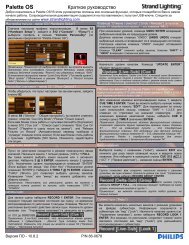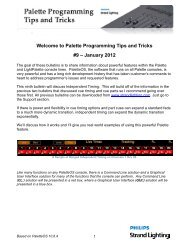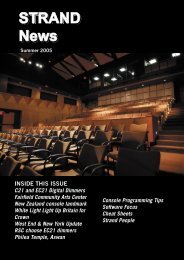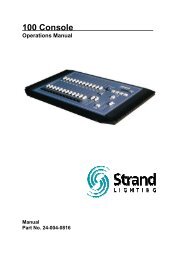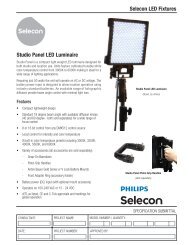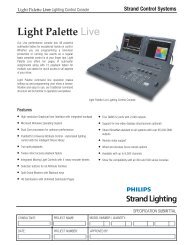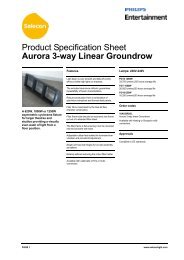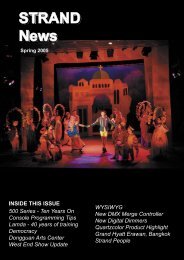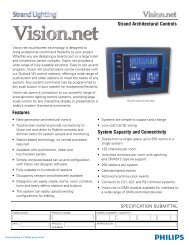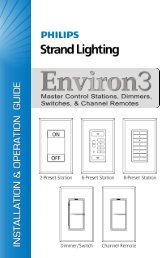You also want an ePaper? Increase the reach of your titles
YUMPU automatically turns print PDFs into web optimized ePapers that Google loves.
STRAND<br />
News<br />
<strong>December</strong> <strong>2004</strong><br />
INSIDE THIS ISSUE:<br />
Our cover story the new Musical Mary Poppins 2<br />
Bobby Harrell’s Diary of a Designer and<br />
Programmer<br />
3<br />
Global Service for Circus Oz 8<br />
Meet New Staff 8<br />
The Woman in White 9<br />
Console Tips—Effects 10<br />
Fiddler on the Roof in Mexico 14<br />
New OneLight Range from Quartzcolor Debuts 15
Mary Poppins!<br />
By Rob Halliday<br />
Page 2<br />
Forty years after the classic Walt Disney film starring Julie<br />
Andrews and Dick Van Dyke appeared in cinemas, the<br />
supercalifradgilisticexpialidocious nanny Mary Poppins<br />
has appeared on stage in a lavish co-production between<br />
Disney Theatrical and Cameron Mackintosh.<br />
Rather than just create<br />
a copy of the film on<br />
stage, the new musical<br />
takes some favourite<br />
movie moments along<br />
with many of the<br />
Sherman Brothers’<br />
fabulous songs and<br />
integrates material from<br />
the original novels by<br />
PL Travers and new<br />
songs by the British<br />
team of George Stiles<br />
and Anthony Drew into<br />
a new book by the<br />
Mary and the Kids award-winning screenwriter<br />
Julian Fellowes.<br />
The production has been brought to the stage by a team<br />
led by director Richard Eyre, co-director and choreographer<br />
Matthew Bourne, co-choreographer Stephen Mear,<br />
designer Bob Crowley and lighting designer Howard Harrison.<br />
Faced with a complex show and a set that left little room<br />
for lighting equipment overhead, Harrison opted for a<br />
largely automated lighting rig - with the further complication<br />
that the director was seeking the lowest possible ambient<br />
noise level and therefore any lighting equipment<br />
used had to be as quiet as possible. The final lighting design<br />
includes the low-noise VL3000Q and VL3500Q spotlights<br />
as well as VL2000 Spot, VL2000 Wash and VL5B<br />
washlights from Vari-Lite, Revolutions from ETC, DHA<br />
Digital Light Curtains plus four colour colour-mixing fluorescent<br />
units from LDDE and colour-mixing LEDs from<br />
Howard Eaton <strong>Lighting</strong> Limited. Rainbow colour scrollers<br />
are used, with their cooling fans and lamp intensities<br />
patched so that the fans only run when the lamps are actually<br />
on.<br />
The Production Tables at the Hippodrome in Bristol<br />
All photos courtesy of Rob Halliday<br />
Control for the entire lighting rig - and for a collapsing<br />
table effect, controlled via wireless DMX, four Hippotizer<br />
digital media servers, two beaMover moving video projectors<br />
and a PC running two PIGI large-format projectors<br />
- is from a <strong>Strand</strong> 500-series control system. Two<br />
<strong>Strand</strong> 530i consoles, one configured as a main console<br />
and the other as a remote, were specified for the production<br />
period, allowing programmer Rob Halliday<br />
and console operator Alex Peters to deal with the<br />
conventional and moving lights - or any combination<br />
of the two - during the technical rehearsal period.<br />
The entire rig now runs from one 530i console<br />
with a 510i console as backup, both running<br />
GeniusPro 2.8.5; ten streams of DMX are distributed<br />
using <strong>Strand</strong>’s ShowNet and SN110 network<br />
nodes. Howard Harrison and his assistant James<br />
Whiteside made use of xConnect dongles on their<br />
Macintosh laptops, both wired and wirelessly, to<br />
view lighting levels and running cues at the production<br />
desk.<br />
Mary Poppins opened at the Bristol Hippodrome<br />
theatre in late September, playing a short season<br />
there before transferring to the Prince Edward<br />
Theatre in London in time for Christmas. The production’s<br />
lighting equipment has been supplied by<br />
Stage Electrics in Bristol, with the installation led<br />
by Production Electrician Fraser Hall and his team<br />
of Chris Luscombe, Steve Reeve, Pete Lambert,<br />
and Ben Jeffrey as well as Pete Loft and the Hippodrome<br />
crew, and Gavin McGrath and his team<br />
at the Prince Edward Theatre.<br />
This issue of <strong>Strand</strong> News features stories on productions<br />
from around the world including a diary from team member<br />
Bobby Harrell of his work over through the autumn and early<br />
winter, Rob Halliday’s contributions from Europe and a story<br />
from Designer and programmer Nicholas Phillips from Mexico.<br />
We would appreciate your feedback on this issue and invite<br />
you to send your comments to:<br />
Editor.Newsletter@strandlighting.com
Diary of a Designer and Programmer<br />
By Bobby Harrell<br />
Page 3<br />
Designing and programming on the <strong>Strand</strong> 500 series<br />
and 300 series desks gives me the opportunity to creatively<br />
solve design challenges through the flexibility and<br />
power of LightPalette software. As a designer, the programming<br />
goal on every show is to find the right path to<br />
intuitively and fluidly create the design. For me, this is<br />
finding the path where the console “thinks” the way I do.<br />
This often means recalling information using text based<br />
labels rather than group numbers.<br />
Opening scene for Playboy of the Western World on a US tour<br />
from the Abbey Theatre in Ireland<br />
Through a chronicle of my fall production schedule, I<br />
will share the programming shortcuts as well as console<br />
setup choices and accessories that I used to<br />
help facilitate the programming of each show. On<br />
some productions I held the position of designer, on<br />
others…the programmer. Sometimes I was brought<br />
in by <strong>Strand</strong> as a lighting systems specialist to consult<br />
with the design team.<br />
Hopefully you will learn as much as I did!<br />
The Dream Ballet from the Oklahoma! tour<br />
As a programmer, the goal is to create the best programming<br />
possible. That may sound simple, but sometimes<br />
that may focus on speed of programming<br />
(because of a fast production period), auto marking for<br />
automated fixtures while other times it may emphasize<br />
designer friendly information to better communicate the<br />
way the designer prefers. Still other applications demand<br />
emphasis on the long term life of the show for productions<br />
like touring. Depending on the application, this will<br />
determine how much setup work is done, how palettes<br />
are setup via macros, screen layouts and multiple console<br />
environments.<br />
August —The Kamikaze Museum<br />
on the USS Intrepid<br />
Auerbach Pollock and Friedlander are known for the<br />
design and planning of performing arts and media<br />
facilities.
Page 4<br />
The new Kamikaze Museum on the USS Intrepid was a<br />
welcome challenge for Steve Friedlander and Alex Bagnall<br />
and they asked me to support them as needed for programming.<br />
A mural of the USS Intrepid<br />
The show tells the story of the USS Intrepid’s involvement<br />
in the World War II battles for the Pacific against the formidable<br />
Japanese fleet. The story is told from the hanger<br />
deck of the mighty aircraft carrier herself while the audience<br />
is surrounded by World War II fighter aircraft.<br />
audio and video, APF selected a <strong>Strand</strong> 310 show<br />
control console to run the show. Fixtures, scrollers,<br />
strobes, EFX 2 scene machines and smoke machines<br />
were integrated with sound and video to create<br />
the event. All attributed fixtures were used intelligently<br />
by way of the Tracker software application.<br />
This allows preset focus groups to display text based<br />
information for color and gobos while Auto Move<br />
While Dark can preset all automated fixtures before<br />
they are needed. Once the cues were written, a<br />
SMPTE cue list was recorded and it’s time was edited<br />
to correspond with the video. SMPTE syncing<br />
can respond differently from one video playback system<br />
to another, so <strong>Strand</strong> gives you the choice of<br />
either using an external SMTPE clock or an internal<br />
one. An internal one was chosen after experimenting<br />
because of playback consistency.<br />
The equipment racks were a level below the hanger<br />
deck in an equipment room that was no where near<br />
the museum. Because of this, Steve and Alex chose<br />
to add a second 300 desk (for the programming period<br />
only) to use on the hanger deck for cueing. Both<br />
desks were connected over a <strong>Strand</strong> network. At that<br />
point, the second desk could either function as a<br />
backup to the first desk or it could act as a second<br />
faceplate known as a remote console. Both console<br />
modes were used as the situation warranted.<br />
Auerbach Pollock and Freidlander’s recreation of the fire aboard the USS<br />
Intrepid while under attack in WW II<br />
A multimedia event, that runs several times a day, using a<br />
mixture of original and produced video on multiple screens<br />
that puts the audience in the middle of World War II battles,<br />
aided by APF’s powerful lighting and atmospheric effects.<br />
With intelligent fixtures and a SMTPE interface to sync with<br />
The equipment racks for the Kamikaze Museum on<br />
the USS Intrepid<br />
September—Oklahoma! Tour –<br />
The Second Leg<br />
When Oklahoma! came to Broadway, David Hersey<br />
chose Ted Mather to be the American <strong>Lighting</strong> Designer<br />
to take care of the show on tour.
Page 5<br />
Rob Halliday (programmer for the West End and Broadway<br />
versions) was available for the first leg of the tour but not<br />
the second, so I went out to program for Ted. The equipment<br />
did not change so it was mostly an opportunity to<br />
make timing and placement adjustments for the new actors.<br />
items using the groups. The preset focus groups are<br />
groups 1 through 750) this allows the operator to always<br />
see a text label for every attribute position making<br />
it much easier to determine if a fixture has malfunctioned<br />
over just looking at raw data.<br />
xConnect<br />
One of the new pieces of technology utilized was<br />
<strong>Strand</strong>’s xConnect software. With xConnect, any<br />
computer can have remote video or can be turned<br />
into a remote console. The software operates on a<br />
PC with Windows 2000 or XP or on a Mac using OS<br />
X. The software comes on a USB key and also contains<br />
all manuals and tutorials. Use the software over<br />
a wired network or go wireless and take your laptop<br />
anywhere in the theatre! Below I’ll explain what<br />
you’re seeing on all 3 screens from the laptop<br />
screenshot below;<br />
A production shot from the Oklahoma! Tour<br />
Although a much smaller version than Broadway, there<br />
are still 17 Studio Colors, 12 VL 2000 Spots, with many<br />
scrollers and effects projectors on this touring rig along<br />
with a <strong>Strand</strong> 550i as a Main desk with a 520i that functions<br />
as an onstage remote and backup.<br />
Laptop screenshot using xConnect for the designer<br />
The two “full” screens are logged in as remote video<br />
so any screen change that happens on the console<br />
will be reflected here on Ted Mather’s laptop. The<br />
middle screen is the main channel screen. This<br />
shows the first 200 channels used in the show.<br />
Screen shoot of a typical cue showing moving lights<br />
All moving light attributes are always referenced to a preset<br />
focus group. (FYI, preset focus groups, sometimes called<br />
reference groups, automatically update cues, effect steps<br />
and submasters as long as channels are inserted into these
Page 6<br />
Notice that you are seeing only certain channels. When a<br />
number is skipped, a vertical line is used as a visual reference<br />
to represent a gap in the number sequence. This is<br />
not just a display option; the channels that are skipped are<br />
channels that have been deleted in the patch so you never<br />
have to bother with them during a channel check.<br />
real estate as possible and you’re done! We went a<br />
step further and recorded this as a macro as we did<br />
it. That way it could always be duplicated if need be.<br />
The screen on the right side of the monitor shows the cue<br />
list…nothing out of the ordinary here.<br />
The cue list for the Oklahoma! Tour<br />
The xConnect Designer Notebook Screens<br />
The screen shot on the left is rather unique as it is showing<br />
only the scroller channels with group reference information.<br />
This is accomplished by logging in on xConnect as User 2.<br />
Remember to use login…not monitor. Now the laptop is a<br />
console! On the laptop, go to User Setup> (Ctrl + F9) Under<br />
Display Options, change Channel Display to GALAXY+,<br />
change Channel Formatting to DISPLAY GROUP. Now, go<br />
to the Group display (Ctrl + F5), highlight group 994.2. This<br />
is the display group for User 2. Simply take out any channels<br />
that you don’t want [CHANNEL LIST @ *]. When you<br />
return to Live (Ctrl + F4) you’ll see your newly adjusted display.<br />
Now just resize your screen to take up as little screen<br />
Scroller channel screen for Ted Mather’s display<br />
Now we have a vertical list of the scroller channels,<br />
levels and their group text reference. This was very<br />
important to Ted as it not only allowed Ted to view<br />
the scroller information intelligently; it allowed me to<br />
enter the information intelligently. For example, if<br />
Ted wanted channel 174 in color L201, he would say<br />
just that and I would type [174 @ TEXT 201 *]. This<br />
would search all groups for the one whose label<br />
started with 201. It would text match below the command<br />
line and then I would press ENTER. This is all<br />
based on how Rob Halliday setup the scroller groups.<br />
I took it a step further by recording the USER macro<br />
to be [@ TEXT]. This only saves one keystroke but<br />
this is a command sequence that Ted repeated many<br />
times. So it was worth it.
October - Playboy of the Western World<br />
Page 7<br />
When Ireland’s Abbey Theatre decided to bring Playboy of<br />
the Western World to the United States for a tour, the lighting<br />
designer, Peter Mumford, asked if I would take care of<br />
the tour for him as his associate. Travis Richardson was<br />
brought on as the lighting supervisor for the tour.<br />
Multiple laptops using multiple USB keys wirelessly<br />
(The laptop on the right utilizing an external monitor)<br />
Generally, Peter Mumford does not use external<br />
monitors at the tech table. Because of the clutter,<br />
size and visual intrusion, he prefers to work without<br />
them. But once he saw that he could have monitors<br />
on his laptop, this gave him the benefits of the<br />
screens without the visual interference. He would<br />
even take his laptop on stage, place it on a soft<br />
goods hamper (for a rolling table) and he could use<br />
his drafting program to locate the channel that he<br />
needed and then we could call it up via the same Apple<br />
laptop! It was the perfect blend of flexibility, compactness<br />
and control.<br />
During rehearsal of Playboy of the Western World at the<br />
Shubert Theatre in New Haven<br />
Production occurred at the Shubert Theatre in New Haven<br />
before it went out on the road. Similar to the previous example,<br />
the show file that I received had been programmed<br />
in GeniusPro so I did the conversion to LightPalette. The<br />
rig itself was fairly simple (at least in terms of control). It<br />
was nothing more than conventional channels and scrollers.<br />
We used both wired and wireless remotes for production.<br />
The wired tended to stay with one person<br />
more and the iPaq would float to wherever it was<br />
needed. With the USB keys and both remote focus<br />
units, we had all the options we needed for control.<br />
What we did not have here was an SN100 for remote<br />
video. So I used 2 USB keys, one connected to my laptop<br />
and one connected to Travis’s laptop and we each connected<br />
a second monitor. This gave us our two dedicated<br />
console screens for the tech table.<br />
The great thing about this is that you can adjust the screen<br />
resolution on the other monitor to have the <strong>Strand</strong> remote<br />
video window fill the screen and not have it affect the laptop<br />
screen.<br />
Both the HP iPaq Focus Remote and the <strong>Strand</strong> R120 Focus
A Truly Worldwide Service!<br />
By Bethan Dickson<br />
Page 8<br />
The specially configured 300 Series console* used by Circus<br />
Oz to enhance their performances all over the world,<br />
was stolen just prior to their London season earlier this<br />
year. Time constraints meant that <strong>Strand</strong> had to replicate<br />
the special configuration console in London ready for opening<br />
night at the Royal Festival Hall in August.<br />
New Staff at <strong>Strand</strong><br />
New Service Engineer appointed in London<br />
Simon Ruck has joined <strong>Strand</strong> London<br />
after working in the lighting<br />
industry as a freelance service and<br />
commissioning engineer for several<br />
years and as a telecommunications<br />
engineer prior to that. He comes<br />
with considerable knowledge of<br />
many types of lighting equipment.<br />
Simon is particularly experienced at<br />
working in the field and his keen fault finding and<br />
inquisitive mind will be a great asset to the organization<br />
. Working alongside well known industry engineering<br />
guru John Wright he has quickly established<br />
himself in his new role.<br />
John Sofranko joins <strong>Strand</strong> Los Angeles Project<br />
Management<br />
John comes to <strong>Strand</strong> after 6<br />
years at the Ruzika Company<br />
working as a project consultant<br />
and systems designer for projects<br />
including International<br />
theme parks, performing arts<br />
facilities and architectural lighting<br />
installations.<br />
Photo: Credit: Ponch Hawkes. Courtesy of Circus Oz<br />
Margaret Burton, Production Manager for Circus Oz said,<br />
"<strong>Strand</strong> <strong>Lighting</strong> were show savers! Despite being on the<br />
other side of the world <strong>Strand</strong> were able to have our desk<br />
customized and ready before we'd even hit the ground in<br />
the UK."<br />
Founded in late 1977, Circus Oz created a new sort of<br />
show for a contemporary audience, they wanted it to be<br />
funny, irreverent and spectacular. Since then they have<br />
performed in over 26 different countries across five continents<br />
to over two million people. They have broken box<br />
office records at the Edinburgh Fringe Festival and represented<br />
Australia at scores of international festivals.<br />
John has worked as a project consultant with Schuler<br />
& Shook Consultants in their Chicago office and also<br />
has extensive experience as an end-user of theatrical<br />
lighting equipment with several theatre companies<br />
around the country. John has recently worked with<br />
the Alabama Shakespeare Company on tour as their<br />
Master Electrician.<br />
David Lee leads European Projects Department<br />
David Lee brings a wealth of experience to his new<br />
role leading the European Projects Department.<br />
David has been a senior project manager for Glantre<br />
Engineering and most recently was lecturing in Project<br />
Management at a University.<br />
David Catterall European Sales Director adds, “David<br />
will extend the depth of experience we have within<br />
our organization as we grow our global projects business.<br />
We are delighted to have him join our team”.<br />
*Original consoles supplied by Bytecraft Entertainment,<br />
Australia
The Woman in White<br />
By Rob Halliday<br />
Page 9<br />
Of course the actors<br />
still had to be lit - both<br />
to render them visible<br />
and to integrate their<br />
reality with the virtual<br />
world of the projections.<br />
This challenging<br />
task fell to lighting designer<br />
Paul Pyant - the<br />
challenge made all the<br />
greater by the fact that<br />
many of the usual solutions<br />
adopted to light<br />
actors while keeping<br />
light away from projection screens, such as<br />
cross-light, were rendered unusable by the<br />
wraparound screen.<br />
First to open in a busy season for new musicals in<br />
London’s West End was the latest work from Andrew<br />
Lloyd Webber, The Woman In White.<br />
Adapted from the classic novel by Wilkie Collins<br />
and directed by Trevor Nunn, the show features a<br />
radical set design from William Dudley created almost<br />
entirely using video projection. With physical<br />
scenery limited to a revolve, a curved grey screen<br />
that wraps around the stage and then a shallower<br />
curved grey screen that can track up and down<br />
stage on the revolve, the vast array of locations<br />
that the show demands - from railway cuttings to<br />
grand castles to the streets of London - are all conjured<br />
up using computer generated scenery projected<br />
from video projectors rigged front-of-house<br />
and on-stage. The artwork often creates a complete<br />
‘virtual world’, scrolling around the projection<br />
screens as characters walk around the stage.<br />
Pyant and his associate lighting designer<br />
David Howe tackled the problem using an<br />
array of carefully chosen automated lighting<br />
equipment, including Vari-Lite VL3000Qs,<br />
Revolutions, AutoYokes and <strong>Strand</strong> Pirouette<br />
PCs, as well as conventional lanterns<br />
fitted with colour scrollers. The overhead rig<br />
was mounted on circular trusses following<br />
the shape of the projection screens, with the<br />
front-of-house rigged on a new auditorium<br />
truss and existing auditorium boom, side circle<br />
and circle front positions. The lighting<br />
then took its lead from the video imagery<br />
with regard to angle and colour, with four<br />
Beamlight followspots used to pick the performers<br />
out while minimizing the light spill<br />
onto the projection screens.<br />
On occasions the lighting was also required<br />
to move with the video, with window gobos<br />
rotating into place as projections panned<br />
around the screen - a challenging task for<br />
programmer Vic Smerdon, who chose to use<br />
a <strong>Strand</strong> control system for the show.<br />
Woman in White runs on a 520i console with<br />
a 510i as backup, this continuing the long<br />
association between the Palace Theatre and<br />
<strong>Strand</strong> - the record-breaking run of Les<br />
Misérables at the theatre was under <strong>Strand</strong><br />
control. Paul Pyant’s team also included assistant<br />
lighting designer James Farncombe<br />
and production electricians Gerry Amies,<br />
Martin Chisnall, Chris Dunford and Ian<br />
Moulds; the show’s lighting equipment was<br />
provided by White Light in London.
Console Tips<br />
By Rob Halliday<br />
Page 10<br />
Effects<br />
Effects in <strong>Strand</strong> 300- and 500-series consoles are<br />
powerful, flexible devices allowing chases to be created<br />
quickly and either played back on their own or as<br />
part of a traditional sequence of cues. Chases can<br />
contain intensities, attributes or any combination<br />
thereof .<br />
Effects can be thought of as self-contained ‘minisequences’<br />
of cues that can be run independently of<br />
the console’s main cue list. The console can contain<br />
up to 600 effects; you can see a list of the effects in a<br />
show by pressing the [FX] display key. Each effect can<br />
then contain up to 99 steps, which you can see by selecting<br />
an effect using the trackball or [NEXT] and<br />
[LAST] keys then pressing the {EDIT FX>} softkey.<br />
Each step has a fade in, fade out and attribute time -<br />
similar to the up, down and attribute times in cues.<br />
There is also a ‘step time’, which is like a ‘wait’ or<br />
‘follow on’ time in a standard cue - the time from when<br />
one step starts until the next step starts automatically.<br />
And - in a crucial difference from standard cues - an<br />
effect step also has a ‘dwell’ time: the time for which<br />
any channels set by a step will stay at their set level<br />
for before fading out again. In other words, a single<br />
effect step can bring up an intensity over a set time,<br />
hold it at that level for a set time, then fade it out<br />
again, whereas a single cue can only bring an intensity<br />
to a level - it needs another cue to fade it out<br />
again.<br />
As an example, let’s take a five-step effect containing<br />
channels 1 to 5, which channel 1 in step 1, channel 2<br />
in step 2 and so on. To record an effect, you can bring<br />
up the channels in live then record as you would record<br />
a cue - ie:<br />
[1] [@] {FULL}<br />
[FX] [1.1] [RECORD] - to record effect 1 step 1<br />
[1] [@][ 0]<br />
[2] [@] {FULL}<br />
[FX] [1.2] [RECORD] - to record effect 1 step 2<br />
and so on, these commands assuming single digit key<br />
entry and so being adapted in the usual way for other<br />
commands modes - eg [RECORD] [FX] [1.1] [*] if in<br />
command line mode.<br />
However, the danger with this is that any other channels<br />
that happen to be up at the time will be recorded<br />
into the effect. You could use UPDATE or other selective-recording<br />
commands to avoid this, but it is often<br />
quicker to make an effect by going to the effect preview<br />
screen and creating it blind there. In the<br />
case of our effect:<br />
[FX] to switch to the FX preview screen<br />
[FX] [2] [*] [*] to create a new effect 2 and<br />
start editing it<br />
[1] [@] [FULL] to add channel 1 to step 1<br />
{APPEND STEP} to add a second step<br />
[2] [@] [FULL] to add channel 2 to step 2<br />
{APPEND STEP} to add a third step<br />
[3] [@] [FULL} to add channel 3 to step 3<br />
and so on until there five step each containing<br />
one channel. If you make a mistake you can<br />
move up and down through the steps using the<br />
trackball or the [NEXT] and [LAST] keys, and<br />
remove a channel with the usual [channel] [@]<br />
[.] or [channel] [@] [*] commands. If you add an<br />
extra step you can remove it using the{DELETE}<br />
softkey. Note, though, that there is no way of<br />
inserting an effect step between two consecutive<br />
effect steps. Also note that effects steps are<br />
like Move Fades - they only affect the channels<br />
they contain, leaving any other channels that<br />
are up in cues or other effects completely unaffected.<br />
An explanation of move fades can be<br />
found in the Summer <strong>2004</strong> issue of the newsletter.<br />
When you’ve made this effect, press {EDIT<br />
FX>} to jump back up to the top half of the effects<br />
screen. This contains settings that govern<br />
the overall behaviour of the effect. Running<br />
through these quickly, there is the effect number<br />
and a text label if you’ve chosen to name the<br />
effect (by pressing the [TEXT] button then a label<br />
in the effects editing screen, or by typing<br />
[FX] [number] [TEXT] [label] in any other screen.<br />
These are followed by ‘Type’, which can be set<br />
to ‘Chase’ or Build’. This decides whether each<br />
step replaces the previous step or adds to it - in<br />
other words whether, when we ran our chase,
Page 11<br />
we’d see channel 1 come on then be replaced by 2<br />
then be replaced by 3, or see channel 1 come on, then<br />
2 add to it, then 3 add to it and so on.<br />
Next is ‘Dir’, which governs the direction the chase<br />
runs in - FWD (runs through the steps in order, so<br />
we’d see channel 1, then 2, then 3 etc, and usually<br />
then loops from the last step to the first), REV (runs<br />
through the steps in reverse order, then loops from<br />
first step to last), BOUNCE (runs from first to last then<br />
back to first and so on) or RANDOM, which fires the<br />
steps in random order and is useful for ‘flickery’ type<br />
chases for flame or lightning effects.<br />
‘Dir’ is followed by ‘Mode’, which can be IndHTP or<br />
LTP. This setting applies only to intensities, and governs<br />
the behaviour of a chase if a light is already on<br />
when the chase is run. Imagine that channel 1 was at<br />
50% when we ran the chase we created above. Do we<br />
want the chase to take channel 1 from 50% to FL then<br />
back to 50%, or from 50% to FL then back to 0? In<br />
IndHTP (‘highest takes precedence’ mode), the light<br />
would go from 50 to FL to 50 in this case -the higher<br />
level from the cue wins over the lower level from the<br />
chase. In LTP (‘latest takes precedence’ mode), the<br />
light would go from 50 to FL to 0 then to FL then to 0<br />
since its last instruction was from the effect telling it to<br />
go to zero.<br />
Next is ‘Level’, which governs whether the chase<br />
turns lights on or off. With our chase above, in<br />
‘Normal’ each light would go from 0 to FL in turn. In<br />
Negative, the moment the chase was started all five<br />
lights would go to FL and each would then switch to<br />
zero in turn. NRM NEG and NEG NRM offer combinations<br />
of these behaviours, while RANDOM will pick a<br />
random level for the lights!<br />
‘Next FX’ allows one effect to automatically trigger<br />
another when it ends. Amongst other uses, this allows<br />
you to overcome the 99 step per effect limit if you<br />
have to - have one effect trigger the next then that effect<br />
trigger the first, setting both effects to only run<br />
once as detailed below.<br />
‘Fade Up’ and ‘Fade Dn’ are the times over which an<br />
entire effect will fade in and fade out when started<br />
manually using the [FX GO] and [FX STOP] keys (for<br />
example, to run the effect created above switch to live<br />
then type [FX] [2] [FXGO]). The times which appear<br />
here by default when you create an effect are set in<br />
the Default Times section of the console’s USER<br />
SETUP screen, accessed by pressing the [SETUP]<br />
key. However, if you start or stop an effect from a cue<br />
- by entering 'F 2' (start effect 2) or ‘f 2’ (stop<br />
effect 2) in the CMD field in the preview screen,<br />
or using the commands [CUE] [1] [FX] [2] or<br />
[CUE] [2] [FX] [-] [2] - then the effect starts or<br />
stops using the up or down time of that cue, or<br />
cue part if you’re using a multi-part cue. This<br />
allows you to re-use the same effect in different<br />
parts of the show with different fade in/out times<br />
without having to make lots of identical effects<br />
with different in/out times - though if you do<br />
have to copy an effect, this is easily done in the<br />
FX display with the command [FX] [new number]<br />
[@] {COPYFROM} [FX] [old number]. ‘Profile’<br />
allows you to have a shaped fade in/out using<br />
any profile stored in the console - profiles can<br />
be found by pressing [MORE] then {PROF DIS-<br />
PLAY}.<br />
‘Stop After’ controls how an effect ends. Usually<br />
it is set to FX STOP, meaning that an effect will<br />
continue to run until it is ended either with [FX<br />
STOP] or by a cue telling the effect to end, or by<br />
the command [FX] [0] [FXGO] which will instantly<br />
stop all running effects. ‘Cycles’ allows<br />
the effect to stop after it has looped a specified<br />
number of times, while ‘Timed’ allows it to stop<br />
after a specified time - a two second burst of<br />
lightning perhaps (-‘Cycles’ doesn’t work very<br />
well if the effect direction is set to random!).<br />
‘Step Control’ then governs how each step is<br />
triggered, usually timed but also manual - a step<br />
won’t run until the [FX STEP] key is pressed - or<br />
trigged by the console’s audio or MIDI inputs.<br />
These are followed by the step timing options -<br />
step time (the time between each step), in (the<br />
time a step fades in over), dwell (how long a<br />
step holds on - if set to ‘off’ the step will hold for<br />
the length of the step time), out (how long a step<br />
takes to fade out), Att (the fade time for any attributes<br />
in the step) and Low/High scaling - for<br />
example, if in our example step 'FL' turned out<br />
to be too bright, you could just adjust the ‘high’<br />
scaling to, say, 50% rather than having to manually<br />
adjust each step. Another useful trick is to<br />
use reference groups (see the Summer 2003<br />
newsletter) containing intensities to make it easy<br />
to adjust levels across many effects steps.<br />
Though times set here affect every step by default,<br />
each step can also have its own times if<br />
necessary - press {EDIT STEPS>} to jump down<br />
to the bottom half of the effect screen then navigate<br />
using the trackball and enter the individual
Page 12<br />
times as required. Effects steps will happily overlap,<br />
allowing complex wave-type chase sequences to be<br />
created. Pressing the {DEFLT} softkey will return a<br />
step‘s timing to the overall chase values set in the top<br />
half of the effect editing screen.<br />
Once created, effects can be run from cues, macros,<br />
submasters or manually as shown above, and multiple<br />
effects can be run at the same time. While running it is<br />
possible to over-ride an effect to alter its speed, direction<br />
or other parameters manually - set your display to<br />
show running effects in the SETUP screen then press<br />
[FX SEL] or [SHIFT]-[FX SEL] to move down or up<br />
through the list of running effects. [FX PAUSE] will<br />
pause a running effect with [FX STEP] then running<br />
steps manually. Alternatively [FX TIME] will then allow<br />
you to alter an effect’s step time on-the-fly using your<br />
console’s wheel (rate wheel on 530 and 550 consoles).<br />
The new timing doesn’t replace the effects programmed<br />
timing unless you want it to -<br />
[UPDATE] [TIME] [FX] [number] [*] [*].<br />
As well as intensities, effects can contain attributes.<br />
Again, these can be recorded from live (only lights<br />
with intensities greater than 0 will be recorded into<br />
effects steps), but it is generally easier to create an<br />
effect in preview having pre-programmed the attributes<br />
you need into reference groups - for example,<br />
make a ‘red’ colour group then a ‘blue’ colour group<br />
then write a chase that alternates the lights between<br />
red and blue. It is also good practice to separate out<br />
attributes, and attributes and intensities, as much as<br />
possible - for example, if writing a colour chase make<br />
sure that it doesn’t contain any pan or tilt information<br />
for the lights, since you’ll then be able to run the chase<br />
at any time regardless of where the lights happen to<br />
be pointing at that time. And if the chase doesn’t contain<br />
intensity then you can have the lights fade up already<br />
chasing by running the effect then fading the<br />
lights up in a cue.<br />
As always, the best advice is to play - don’t be<br />
afraid to experiment, and see what happens! But<br />
one last tip if you do become addicted to effects<br />
and end up with busy effects sequences of effects<br />
triggered by cues in your show: you might find that<br />
the effects take a few fractions of a second to kick<br />
in as the console retrieves the effect information<br />
from its hard drive - particularly if you’re using an<br />
older, slower console. If your effects run to the beat<br />
of music, this can be a problem, but it’s easily overcome:<br />
write a macro that pre-loads the effects:<br />
[FX] [1] [FX LOAD]<br />
[FX] [2] [FX LOAD]<br />
and so on, and run that macro from a cue at the<br />
start of your show or in a quiet moment before a<br />
busy effects sequence. That way, the console will<br />
have the effects ready to go the instant you need<br />
them!<br />
And finally, if you’re recording cues while effects<br />
are running don’t forget that the [RECORD] key<br />
captures everything - and so will store channels set<br />
as the effect has them set at that precise moment,<br />
which is usually a bad thing. On the other hand the<br />
[REC-SUB] key will ignore the contribution of any<br />
effects as well as any submasters, and [UPDATE] -<br />
see the Spring 2003 Newsletter - will also ignore<br />
channels being controlled by effects.<br />
A collection of Console Tips is now available on the<br />
<strong>Strand</strong> <strong>Lighting</strong> Website at<br />
http://www.strandlighting.com select the support<br />
tab and Newsletter and then Console tips.<br />
Things to note when running effects containing attributes:<br />
when the effect starts the ‘fade in’ time doesn’t<br />
really have any effect: an attribute will move the first<br />
time a step tells it to move somewhere. More importantly,<br />
when an effect ends you need to tell the lights<br />
where to go as otherwise they can end up in a ‘semirandom’<br />
position if the effect stops halfway through<br />
directing a light to a new position. When running effects<br />
from cues, the trick is to have a cue end the effect<br />
in 0 time, give that cue a very short wait time (say<br />
0.1second) then have a follow-on cue that then sets<br />
the lights to the position/colour you want them to go to<br />
in the time you want them get there over.
Violinista en el Tejado<br />
Fiddler on the Roof<br />
When lighting designer Jason Kantrowitz asked his programmer<br />
Nicholas Phillips what control system should be<br />
specified for a new production of Fiddler on the Roof in<br />
Mexico City, Phillips’ response was indisputably <strong>Strand</strong> 500<br />
Series. A new 520i console, SN110 nodes powered over<br />
Ethernet, and peripherals were added to an existing, near<br />
first generation 550 console the producer had previously<br />
acquired. Taking full advantage of the 500 Series’ total<br />
backwards compatibility, only one console needed to be<br />
purchased to form a comprehensive control system which<br />
otherwise would have had to be deducted from the moving<br />
light and scroller budgets.<br />
Nicholas Phillips (foreground) and designer Jason Kantrowitz at the Tech<br />
Table<br />
"I like the 500 series as I really appreciate the way it is capable<br />
of controlling all of the devices on this project as a<br />
complete package today. The platform is an imminence<br />
help in maintaining a high level of organization and clarity<br />
for both the programmer and designer,” says Nicholas. Six<br />
universes of DMX were used to manage the system with<br />
several types of dimmers (including <strong>Strand</strong> CD80’s), moving<br />
lights, scrollers, and fiber optics. The moving light package<br />
consisted of two Martin Professional MAC2000 Profile<br />
II, and six Martin Professional MAC2000 Wash fixtures.<br />
Nicholas continues, “The SN110’s were most helpful to the<br />
crew as the text labels left little question as to what should<br />
be plugged into which port. Being able to use six universes<br />
of DMX kept address numbers low and easily managed.”<br />
Page 13<br />
The designer’s displays were served using a desktop computer<br />
configured with a dual video card and running<br />
<strong>Strand</strong>’s X-Connect. “Having two monitors and X-Connect<br />
allowed Jason and I to customize four windows that presented<br />
him with the most pertinent information while<br />
cueing the show. One monitor showed a window of<br />
two-hundred channels at twenty across, and another<br />
window with a scrollers only display group arranged<br />
in Galaxy+ Tracker Preset format. The second monitor<br />
showed him a live cue list with submasters, and<br />
the fourth window, a full screen cue list in history format.<br />
During techs and dresses I positioned the 520i<br />
console adjacent to Jason at the lighting table. Using<br />
X-Connect on my laptop, I was able to log into the<br />
550 console that I left back in the booth and take<br />
control without having to run back and physically be<br />
there.” Jason comments, “The scrollers window was<br />
great; it let me quickly glance up and see both the<br />
level and color of each fixture. No other system has<br />
shown this to me so clearly before.” Stage management<br />
received cue list information via an existing<br />
SN100 node. The 520i was equipped with a second<br />
video card giving Phillips three displays at the console.<br />
This allowed him to view all channels at one<br />
time which aided him in quickly viewing levels for the<br />
entire show.<br />
“<strong>Strand</strong>’s WiFi remote application for my iPaq was a<br />
big help. Jason and I were the only two on the lighting<br />
team, and I often found myself having to solve<br />
problems in various areas of the theater while Jason<br />
was working on stage. Having the remote, and a<br />
great walkie-talkie, allowed me to be in two places at<br />
once without having to be tied down. The wireless<br />
signal was quite strong; I could control the system<br />
most anywhere in the complex, even from across the<br />
street!” An R140 wired remote was also specified as<br />
part of the system for its ruggedness in day to day<br />
operations over the life of the system which is sure to<br />
see several more open-ended production runs.
Page 14<br />
New Application Resource<br />
Guide Available<br />
We are pleased to announce that our latest edition<br />
application Resource Guide CD ROM is now available.<br />
Packed with useful information the guide features:<br />
As for programming a show like Fiddler on the Roof on the<br />
500 series, Nicholas says, “AutoMod and the new Trackback<br />
command proved useful. As the design developed I<br />
could easily rearrange channels for Jason using AutoMod<br />
either temporarily or permanently, globally or selectively.<br />
Although, by far the best aspect of this system is the ability<br />
to spreadsheet style edit in the live command line. Moving<br />
channel levels and selectively updating is graceful on the<br />
500 and is something that we constantly do. Having the<br />
ability to assign macros to comfortable buttons for me is a<br />
level of customizability I am finding hard to live without on<br />
other consoles. Overall, there is little doubt of the 500 Series’<br />
superiority in controlling Broadway and theatrical style<br />
shows today."<br />
• Informative PowerPoint presentations<br />
• Technical documents including console manuals<br />
• Quartzcolor Product Spares<br />
• A complete set of Data Sheets for 120 and 230<br />
volt products<br />
• AutoCad drawing files for main system components<br />
• Product tutorials<br />
• Product Specifications<br />
<strong>Strand</strong> provided comprehensive<br />
support<br />
throughout the fit-up<br />
and cueing process.<br />
The dealer for the new<br />
control package was<br />
Stagelight, Inc. of<br />
Houston, Texas.<br />
Disks are available from your nearest <strong>Strand</strong> Sales<br />
office.<br />
Nicholas Phillips is a lighting and projection designer having<br />
designed for such companies as American Ballet Theater,<br />
Houston Ballet, Miami City Ballet, Washington Ballet,<br />
Ballet Memphis, Dominic Walsh Dance Theater, and<br />
Stages Repertory Theater. He is a regular contributor to<br />
both <strong>Lighting</strong> Dimensions and Entertainment Design magazines.<br />
We appreciate his contribution to this story
Page 15<br />
Introducing the OneLight Family<br />
of Studio and Location Lights<br />
from Quartzcolor<br />
The new OneLight range from Quartzcolor provides a host<br />
of benefits from these powerful and low energy family of<br />
luminaires. In the studio the new 150 watt and 250 watt<br />
CDM Fresnels provide 3000 0 K and 3200 0 K colour balanced<br />
sources in two compact bodies.<br />
The OneLight 575 watt<br />
Fresnel and Par<br />
The 250 watt and 150 watt CDM<br />
Studio Fresnels<br />
The 250 watt CDM fresnel is provided with a Universal<br />
Power supply and may be used for 120 and 230 volt applications<br />
and its powerful lamp provides light levels approaching<br />
a 1kW Tungsten Fresnel. The 250 watt CDM unit<br />
offers hot restrike capability. The more compact 150 watt<br />
unit is currently only available for 230 volt applications and<br />
matches many 500 and 650 watt units. Both feature exceptional<br />
lamp life.<br />
The new CDM fresnels are ideal for a range of studio applications<br />
where long lamp life and low energy consumption is<br />
required. News studios will particularly appreciate these<br />
compact and cool light sources. The CDM 150 is available<br />
with 3000 0 and 4000 0 CDM short arc lamps to colour balance<br />
with a wide range of tungsten and fluorescent lamps.<br />
On location the new OneLight 575 watt MSR Par and Fresnels<br />
offer the power of a standard 575 watt daylight source<br />
in a compact integrated enclosure. All OneLight 575 watt<br />
luminaires feature:<br />
• Universal Voltage Operation<br />
• Fully Integrated Flicker Free Electronic<br />
Ballast<br />
• Hot Restrike Operation<br />
• Built in Dimmer with a range form<br />
full to 50%<br />
• Optional Plug in DMX control module<br />
for remote operation<br />
• Remote Start on Power up<br />
Optional plug in DMX module<br />
Both units feature new PowerGems ClearArc technology<br />
ballasts that dramatically improve light output<br />
throughout the life of the lamp. ClearArc Ballast technology<br />
can Reduce de-vitrification which means<br />
lamps burn cleaner through and beyond their rated<br />
life. Lamp ‘sing’ is also reduced keeping the sound<br />
engineers happy.<br />
All OneLight units are easy<br />
to maintain and offer rapid<br />
exchange of ballasts. Ballasts<br />
can be exchanged by<br />
removing a few fasteners<br />
and plugging in a new ballast<br />
in less than a minute.<br />
Cost effective OneLight Fresnels and Pars may be<br />
used in a variety of applications from Film location<br />
work to Trade Show and Exhibition <strong>Lighting</strong>.<br />
The <strong>Strand</strong> Newsletter is published electronically<br />
four times a year. If you received<br />
a copy of this newsletter from an associate<br />
and would like to receive a copy directly<br />
please email us at:<br />
newsletter@strandlight.com<br />
We hope that you enjoyed this issue of the <strong>Strand</strong><br />
Newsletter and would like to wish all of our readers<br />
a Happy and Successful New Year.




